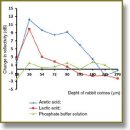
Depth-Resolved Dynamics of Aceto-Whitening in Rabbit Cornea Studied by 1300 nm Optical Coherence Tomography
In many developing parts of the world, colposcopy supplemented by aceto-whitening remains the most widespread means of reliably diagnosing cervical dysplasia, potentially leading to cervical cancer. The use of aceto-whitening to enhance detection rates for Barrett’s esophagus is also emerging in recent years. Here we quantitatively study the aceto-whitening phenomenon using 1300 nm optical coherence tomography. By exposing a simple epithelial tissue model (excised rabbit cornea) to 0.5 M acetic acid we report for the first time to our knowledge the direct measurement of the time over which the cellular brightening effect propagates down through the epithelial layer and into the stroma (~50 s). We also measure the magnitude of the cellular brightening effect in quantified units (~10 dB in the epithelium). We also exposed the rabbit corneas to two control substances for clinical aceto-whitening, 0.5 M lactic acid and phosphate buffered saline. Phosphate buffered saline produced no discernible change in the optical properties of the corneas. However we noted that lactic acid (an alpha-hydroxy acid) produced a pronounced brightening in the epithelial layer also, peaking at 8 dB after 20 s. The main distinction with acetic acid was a lack of effect in the corneal stroma. This may point to a way of giving OCT imaging the ability to discriminate between cells of epithelial vs fibroblastic phenotype.
- Collier T., Lacy A., Richards-Kortum R., Malpica A., Follen M. Near real-time confocal microscopy of amelanotic tissue: detection of dysplasia in ex vivo cervical tissue. Acad Radiol 2002; 9(5): 504–512, http://dx.doi.org/10.1016/s1076-6332(03)80326-4.
- Hoffman A., Goetz M., Vieth M., Galle P.R., Neurath M.F., Kiesslich R. Confocal laser endomicroscopy: technical status and current indications. Endoscopy 2006; 38(12): 1275–1283, http://dx.doi.org/10.1055/s-2006-944813.
- Zysk A.M., Nguyen F.T., Oldenburg A.L., Marks D.L., Boppart S.A. Optical coherence tomography: a review of clinical development from bench to bedside. J Biomed Opt 2007; 12(5): 051403, http://dx.doi.org/10.1117/1.2793736.
- Coleman A.J., Richardson T.J., Orchard G., Uddin A., Choi M.J., Lacy K.E. Histological correlates of optical coherence tomography in non-melanoma skin cancer. Skin Res Technol 2013; 19(1): e10–e19, http://dx.doi.org/10.1111/j.1600-0846.2012.00626.x.
- Pierce M.C., Javier D.J., Richards-Kortum R. Optical contrast agents and imaging systems for detection and diagnosis of cancer. Int J Cancer 2008; 123(9): 1979–1990, http://dx.doi.org/10.1002/ijc.23858.
- Xia Y., Hallas N.J. Shape-controlled synthesis and surface plasmonic properties of metallic nanostructures. MRS Bulletin 2005; 30(5): 338–348, http://dx.doi.org/10.1557/mrs2005.96.
- MacLean A.B. Acetowhite epithelium. Gynecol Oncol 2004; 95(3): 691–694, http://dx.doi.org/10.1016/j.ygyno.2004.08.006.
- Maddox P., Szarewski A., Dyson J., Cuzick J. Cytokeratin expression and acetowhite change in cervical epithelium. J Clin Pathol 1994; 47(1): 15–17, http://dx.doi.org/10.1136/jcp.47.1.15.
- Marina O.C., Sanders C.K., Mourant J.R. Effects of acetic acid on light scattering from cells. J Biomed Opt 2012; 17(8): 085002, http://dx.doi.org/10.1117/1.jbo.17.8.085002.
- Longcroft-Wheaton G., Duku M., Mead R., Poller D., Bhandari P. Acetic acid spray is an effective tool for the endoscopic detection of neoplasia in Barrett’s esophagus. Clin Gastroenterol Hepatol 2010; 8(10): 843–847, http://dx.doi.org/10.1016/j.cgh.2010.06.016.
- Yagi K., Aruga Y., Nakamura A., Sekine A., Umezu H. The study of dynamic chemical magnifying endoscopy in gastric neoplasia. Gastrointest Endosc 2005; 62(6): 963–969, http://dx.doi.org/10.1016/j.gie.2005.08.050.
- Kawahara Y., Takenaka R., Okada H., Kawano S., Inoue M., Tsuzuki T., Tanioka D., Hori K., Yamamoto K. Novel chromoendoscopic method using an acetic acid-indigocarmine mixture for diagnostic accuracy in delineating the margin of early gastric cancers. Dig Endosc 2009; 21(1): 14–19, http://dx.doi.org/10.1111/j.1443-1661.2008.00824.x.
- Bhalang K., Suesuwan A., Dhanuthai K., Sannikorn P., Luangjarmekorn L., Swasdison S. The application of acetic acid in the detection of oral squamous cell carcinoma. Oral Surg Oral Med Oral Pathol Oral Radiol Endod 2008; 106(3): 371–376, http://dx.doi.org/10.1016/j.tripleo.2008.01.017.
- Balas C., Papoutsoglou G., Potirakis A. In vivo molecular imaging of cervical neoplasia using acetic acid as biomarker. IEEE J Select Topics Quantum Electron 2008; 14(1): 29–42, http://dx.doi.org/10.1109/jstqe.2007.913396.
- Balas C. A novel optical imaging method for the early detection, quantitative grading and mapping of cancerous and precancerous lesions of cervix. IEEE Trans Biomed Eng 2001; 48(1): 96–104, http://dx.doi.org/10.1109/10.900259.
- van Praag E.V. Corneal abrasion and ulceration in rabbits. Available: http://www.medirabbit.com/EN/Eye_diseases/Disorder/Ulcer/Ulc_en.htm.
- Du L., Wu X., Pang K., Yang Y. Histological evaluation and biomechanical characterisation of an acellular porcine scaffold. Br J Opthalmol 2011; 95(3): 410–414, http://dx.doi.org/10.1136/bjo.2008.142539.
- Hahne M., Reichl S. Development of a serum-free human cornea construct for in vitro drug absorption studies: the influence of varying cultivation parameters on barrier characteristics. Int J Pharm 2011; 416(1): 268–279, http://dx.doi.org/10.1016/j.ijpharm.2011.07.004.
- Masters B.R., Paddock S. In vitro confocal imaging of rabbit cornea. J Microsc 1990; 158(2): 267–274, http://dx.doi.org/10.1111/j.1365-2818.1990.tb03000.x.
- Ojeda J.L., Ventosa J.A., Piedra S. The three-dimensional microanatomy of the rabbit and human cornea. A chemical and mechanical microdissection-SEM approach. J Anat 2001; 199(5): 567–576, http://dx.doi.org/10.1046/j.1469-7580.2001.19950567.x.
- Deshpande P., Notara M., Bullett N., Daniels J.T., Haddow D.B., MacNeil S. Development of a surface-modified contact lens for the transfer of cultured limbal epithelial cells to the cornea for ocular surface diseases. Tissue Eng Part A 2009; 15(10): 2889–2902, http://dx.doi.org/10.1089/ten.TEA.2008.0528.
- Kocsis E., Trus B.L., Steer C.J., Bisher M.E., Steven A.C. Image averaging of flexible fibrous macromolecules: the clathrin triskelion has an elastic proximal segment. J Struct Biol 1991; 107(1): 6–14, http://dx.doi.org/10.1016/1047-8477(91)90025-r.
- Patel S.V., McLaren J.W., Camp J.J., Nelson L.R., Bourne W.M. Automated quantification of keratocyte density by using confocal microscopy in vivo. Invest Opthalmol Vis Sci 1999; 40(2): 320–336.










